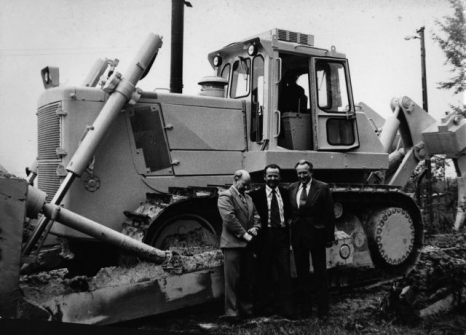
GREEN, YELLOW... STEEL. Products of the Southern Works and Stalowa Wola Steelworks
2.06.2020-1.10.2022, open-air exhibition, square in front of the Inter-University Library in Stalowa Wola, 10 Ks. J. Popiełuszki St.
From Southern Works to HSW S.A.
The originator of the creation of Zaklady Południowe (Southern Works) was Eng. Marceli Siedlanowski, director of Katowice’s Baildon Steelworks, who wanted to create a branch of his expanding production, but impossible to expand within the city limits, somewhere in the south, away from potential war threats. Decision-makers from the government accepted the idea, expanding the project – there was to be not a subsidiary, but an independent metallurgical plant, in addition to a mechanical plant. The entire investment was included in the plan for the emerging Central Industrial District.
Eng. Siedlanowski headed a committee looking for a suitable site for the factory, and it was he who decided that it would be built near the village of Plawo. A limited liability company was established. (1937), which included the consortium Huta Pokój – Śląskie Zakłady Górniczo-Hutnicze S.A. (responsible for erecting the smelter) and the Society of Starachowice Mining Plants S.A., (to build a mechanical plant). A contract was signed with the Ministry of Military Affairs to carry out the investment.
The first pine trees for the construction were cut down in March 1937, and since work was being done at a truly “Cop” pace, on June 14, 1939 Polish President Ignacy Moscicki officially opened the already producing Southern Works – a steel mill smelting stainless steel and a mechanical plant producing artillery equipment and steam turbines. The undoubted father of ZP’s success was Marceli Siedlanowski, the company’s president and chief executive officer, who was able to assemble a professional staff and adhere to the highest quality standards of both the investment being erected and the products being manufactured.
The war derailed the development plans. The German occupiers appreciated the enormous potential of the seized plants and tried to exploit it. Werk Stalowa Wola continued to produce cannons, including the famous cannon, simultaneously anti-aircraft and anti-tank Flak 8.8. Withdrawing, the Germans devastated the plants and stripped them of valuable equipment.
The first post-war years were dominated by attempts to recover exported machinery and hard work to get the factory up and running. Initially, products were produced to meet the needs of the still-fighting armies, then what was needed by the reborn state and society. Production of field and tank cannons under Soviet license was undertaken. In 1948, the name of the Southern Works was changed to Huta Stalowa Wola.
It took a long time to find the right production profile, dealing with manufacturing for the agricultural, construction, oil, mining and even automotive industries. From this search emerged HSW’s first flagship products – compressor units and battery trucks.
And finally another providential husband appeared in the history of the company – Eng. Zdzislaw Malicki (1965) became the general director of HSW. He decided to specialize in the production of construction machinery and to cooperate with Western companies and use their technologies. In doing so, he was able to overcome the reluctance of reluctant government decision-makers and the distrust of Western contractors, as well as stir up enthusiasm among his staff for introducing innovative solutions. The result of these bold deeds was a change in the production profile and successive batches of hit products: excavators KM 602a, concrete mixers under license from the German Stetter, cranes based on cooperation with the British companies Jones and Coles, loaders with the famous Ł-34 and, finally, crawler tractors under license from the American Harvester, with the TD-40 giant developed in Stalowa Wola. Added to this were drive bridges (under American license from Clark), gearboxes and gears.
The hits of the classified military production were the MT-LB armored personnel carriers with their modifications Opal I and II, used as chassis for many types of combat vehicles, and the self-propelled 122 mm howitzers Goździk
The merger of the steel mill and the already greatly expanded mechanical plants into the HSW structure made the company largely self-sufficient.
In 1972 the Industrial Combine Huta Stalowa Wola was established, which also included branches in Janów Lubelski, Leżajsk, Strzyżów and Zaklików, as well as factories in Suchedniów and Radomsko. The company, already a world leader in the production of construction machinery, employed more than 20,000 people.
The 1980s were a period of political transition, with a significant role played by representatives of the HSW staff. The plant found itself relatively well in the new economic reality, maintaining the current profile of civilian production. Military production included armored vehicles of various types and applications, as well as the smelting of quality steels for the defense industry.